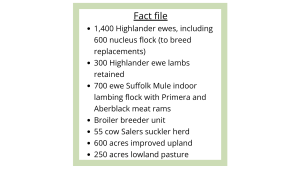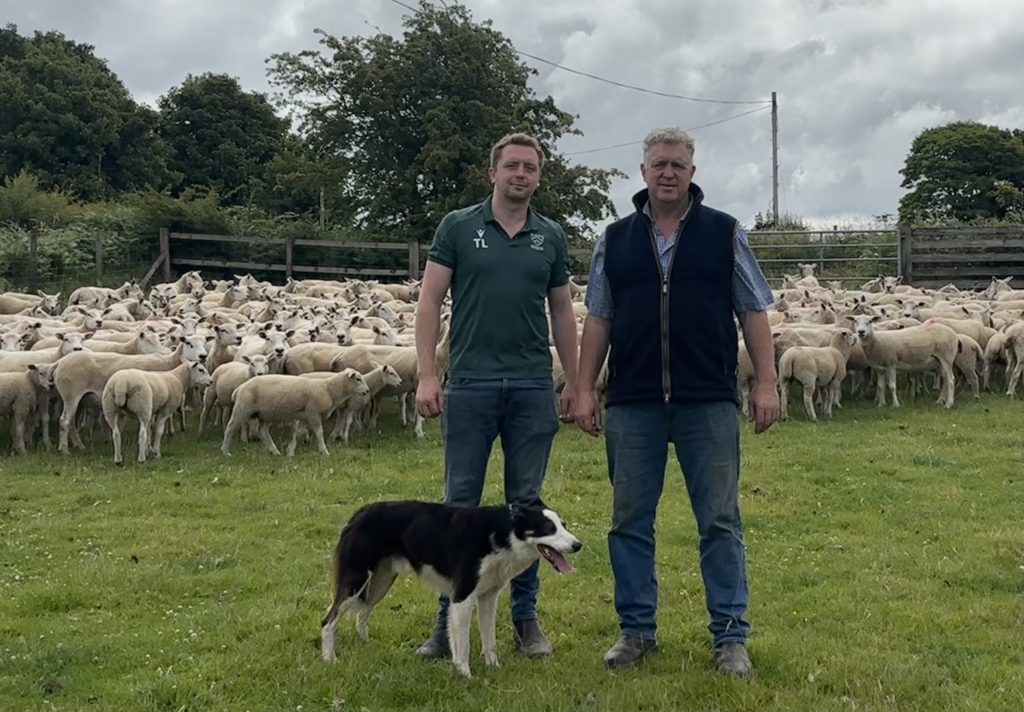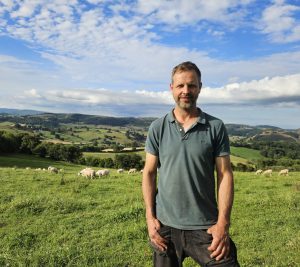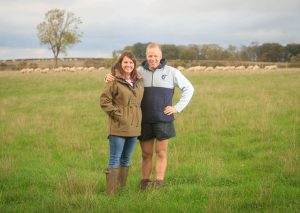with thanks to Thomas and Andrew Lloyd, Clyro, Powys
Thomas Lloyd says the Highlander has enabled his family to combine ease of management with efficiency in their busy business, so much so they’re able to lamb 1,100 Highlander ewes outdoors in three weeks with minimal intervention. “In fact, the Highlander has enabled us to sufficiently reduce our workload and disease so that if opportunities arose, expansion wouldn’t be a problem with our existing resources.
We’ve built up the flock over the last 10 years by breeding up from Cheviot Welsh ewes with the Highlander from Innovis…
“Our objective is to maximise performance from reduced inputs – both fixed and variable,” he explains. “We’ve built up the flock over the last 10 years by breeding up from Cheviot Welsh ewes with the Highlander from Innovis; we’re finding these 75kg ewes scan around 180% with minimal triplets and barrens and we can lamb them outdoors and maximise lamb performance off grass as much as we can.
“The lambs are weaned at an average 13 weeks when we drench and move them to clean improved grazing which includes herbal leys and they thrive without any concentrate. We put 40% of the flock to the Aberblack or Primera meat rams with lambs finishing at an average of 20kg, most grade within the U, R spec and KO at 45%.

“We’ve eliminated joint ill and other indoor lambing health issues by lambing outdoors, most notably reducing lameness within the flock. Once the lambs are born, we’ve found the flock requires minimal management, for example by early July they’ve been touched just twice – at marking and shearing.
“We’re lambing from 1 April and it’s a two-person job most of the time,” he says “We check the outdoor ewes twice a day, and despite the fact they come thick and fast – 95% of ewes lamb within the first three weeks, they require minimal intervention. Highlanders go off and find their own space so there’s no mix up, and afterwards they take their lambs with them. In fact, we found the more we intervene, the more problems we get.
“We still can’t get over the lambs’ vigour; as soon as they hit the deck they’re up and away looking for colostrum and the ewes definitely have plenty of that. Any ewes that do require intervention during lambing are brought back to the homestead and placed into a separate flock so the lambs will not be kept for breeding.”
Bred and reared from forage, the Highlander has also enabled the Lloyds to minimise purchased feed. “We introduce the ewes to strip graze fodder beet two months pre lambing, they’re then set stocked on rested grassland at lambing at five to seven ewes per acre. Afterwards we mob up into groups of 150 to 200 ewes, introduce to quality leys, and move them on once or twice a week.”
The ewes are averaging five crops and remain in BCS 3 virtually 365. “They’re very easily managed and similarly the rams are working for five years; we introduce one to 80 ewes, and they too pretty much stay in BCS 3 all year round.
Closing up has been really important as we don’t want to buy in any issues from other flocks…
“We don’t performance record as such, however we do mark-up ewes for various reasons including those with twins we prioritise to retain and introduce to the nucleus flock. Closing up has been really important as we don’t want to buy in any issues from other flocks,” he explains.
When it comes to investing in new rams, Thomas says: “We select Highlanders for lambing ease and growth rates, and Aberblack and Primeras for similar traits and muscle depth. Looks aren’t important, loin width and fat cover is key for us to improve ease of finishing. The great thing about Innovis rams is they’re properly performance recorded for commercial traits. Their EBVs tell you in black and white what the ram is going to pass on to its progeny. We’ve done our own trials and we found the proof was definitely in the pudding.”



